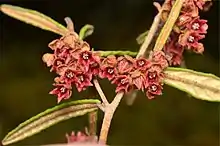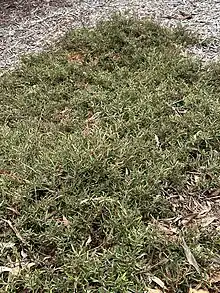| Tasmanian velvetbush | |
|---|---|
 | |
| Lasiopetalum micranthum in the Tasmanian Bushland Garden | |
| Scientific classification | |
| Kingdom: | Plantae |
| Clade: | Tracheophytes |
| Clade: | Angiosperms |
| Clade: | Eudicots |
| Clade: | Rosids |
| Order: | Malvales |
| Family: | Malvaceae |
| Genus: | Lasiopetalum |
| Species: | L. micranthum |
| Binomial name | |
| Lasiopetalum micranthum | |

Lasiopetalum micranthum is a species of flowering plant in the family Malvaceae and is endemic to a small region of eastern Tasmania. It is a low, spreading shrub with thin, rusty-hairy branches, narrow oblong leaves and drooping, star-shaped red to greyish-pink or white flowers.
Description
Lasiopetalum micranthum is a low, spreading shrub that typically grows to a height of up to 50 cm (20 in), its branches covered with rust-coloured, star-shaped hairs. The leaves are narrow oblong, mostly 29–60 mm (1.1–2.4 in) long, the edges rolled under and depressions above the veins on the upper surface. The flowers are borne in drooping groups with brown sepal-like bracts and red to greyish-pink or white petal-like sepals. The fruit is a hairy capsule up to 8 mm (0.31 in) wide.[2][3][4]
Taxonomy
Lasiopetalum micranthum was first formally described in 1855 by Joseph Dalton Hooker in The botany of the Antarctic voyage of H.M. Discovery ships Erebus and Terror from a specimen collected by Ronald Campbell Gunn.[5][6] The specific epithet (micranthum) means "small-flowered".[7]
Distribution and habitat
This lasiopetalum grows in forest or woodland at altitudes of up to 300 m (980 ft) in the central east coast of Tasmania between the Meredith and Swan Rivers near Swansea.[2][3][4]
Conservation status
Lasiopetalum micranthum is listed as "rare" under the Tasmanian Government Threatened Species Protection Act 1995.[2][3][4]
References
- ↑ "Lasiopetalum micranthum". Australian Plant Census. Retrieved 19 March 2022.
- 1 2 3 "Lasiopetalum micranthum" (PDF). Australian Government Department of Agriculture, Water and the Environment. Retrieved 19 March 2022.
- 1 2 3 Jordan, Greg. "Lasiopetalum micranthum". University of Tasmania. Retrieved 19 March 2022.
- 1 2 3 "Threatened species link - Lasiopetalum micranthum". Tasmanian Government Department of Natural Resources and Environment Tasmania. Retrieved 19 March 2022.
- ↑ "Lasiopetalum micranthum". APNI. Retrieved 19 March 2022.
- ↑ Hooker, Joseph Dalton (1860). The botany of the Antarctic voyage of H.M. discovery ships Erebus and Terror in the Years 1839-1843 :under the command of Captain Sir James Clark Ross (Part III Flora Tasmaniae). Vol. 1. London: Lovell Reeve. pp. 51–52. Retrieved 19 March 2022.
- ↑ Sharr, Francis Aubi; George, Alex (2019). Western Australian Plant Names and Their Meanings (3rd ed.). Kardinya, WA: Four Gables Press. p. 251. ISBN 9780958034180.
